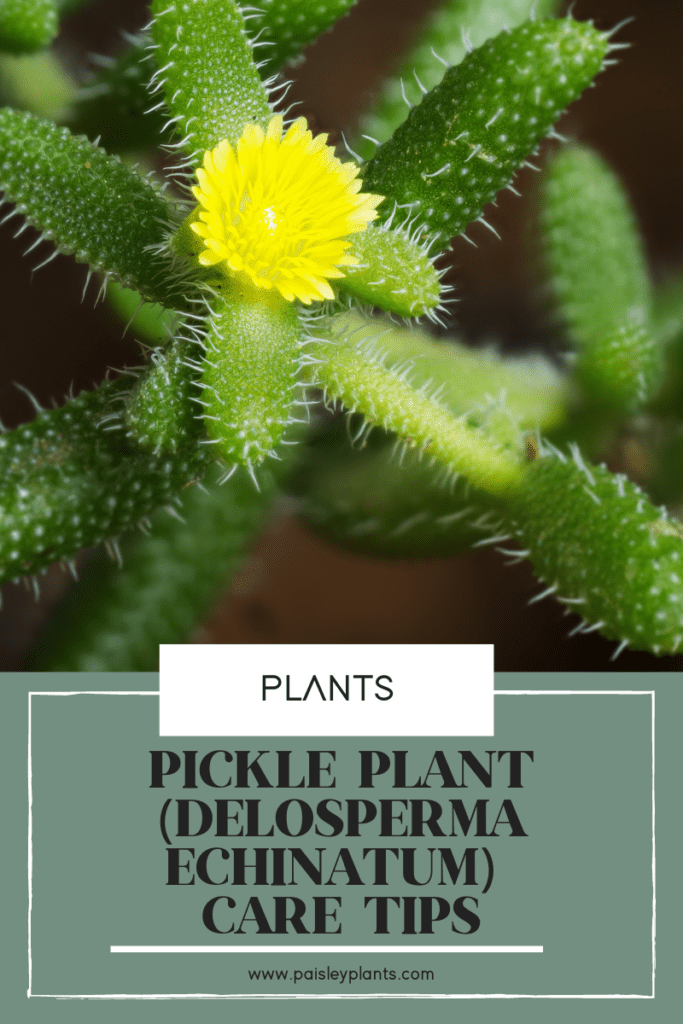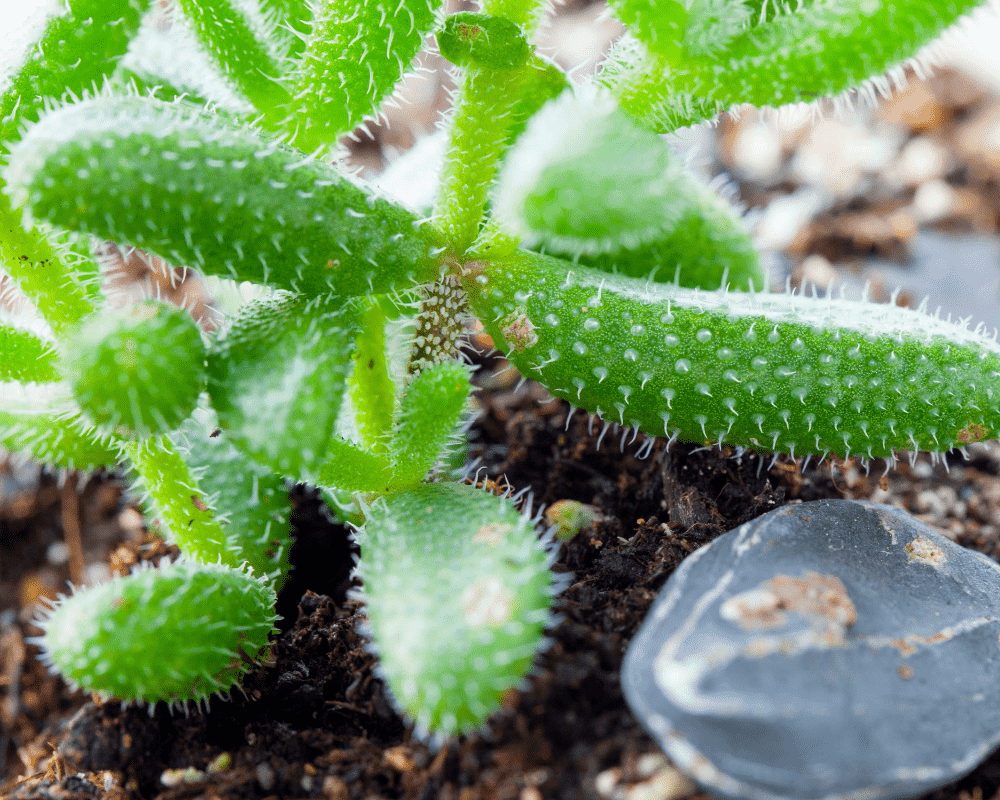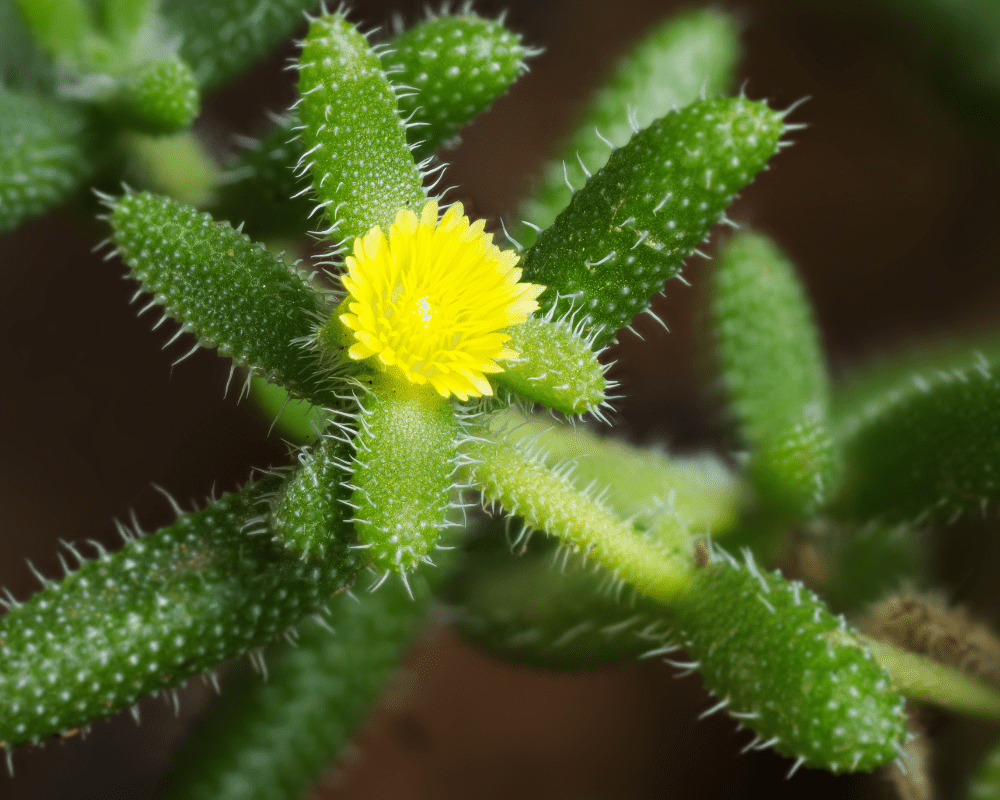Did you ever hear your grandma say she was “in a pickle?” Maybe not, but if you did, it meant she was in a difficult place – like being between a rock and a hard place. Or maybe in a dilemma.
Well, I bet she never heard of a Pickle Plant (Delosperma Echinatum)! I know that would have gotten a good giggle out of my grandma! She always loved a good laugh and also loved to learn about new things. I also know she never heard of a Pickle Plant.
The two Greek words “delos” and “sperma” mean exposed seed. And, believe it or not, there are more than one kind of Pickle Plant!
Table of Contents
Background and History

This post includes affiliate links.
The Pickle Plant or Pickle Cactus (Delosperma Echinatum) is native to the rocky habitat of the Eastern Cape of South Africa. It is a unique plant with spiny looking leaves covered in tiny white translucent hairs.
This plant (Pickle Plant – Delosperma Echinatum) should not be confused with another type of Pickle Plant (Senecio Stapeliiformis). They are from totally different species and look totally different.
Unlike a cactus, the hairs on this Pickle Plant are soft to the touch, so won’t prick your fingers. These soft, translucent hairs refract the light and allow them to sparkle like ice crystals. This plant is sometimes also referred to as an Ice Plant for this reason.
The cute, plump little leaves resemble gherkin pickles, thus the name, Pickle Plant or Pickle Cactus. In an indoor setting, these plants remain small and compact so they are perfect to put on a shelf or small places. This makes these plants even cuter!
In its native setting, it usually spreads as a low, creeping mat in rocky habitat, but its stems can grow up to 18.0” long. It is a relatively slow grower. When it blooms, the blossoms are tiny, pale yellow flowers that resemble small daisies.
Toxicity
One good feature of the Pickle Plant is its non-toxicity to young children or animals. The tiny hairs (which appear to be prickly) are actually soft to the touch and are relatively harmless.
You can consider this to be a friendly plant to have in your home around your children or pets. Obviously, you should always keep any plants out of reach of naughty (or maybe curious?) kids or pets just to be safe!
(Find other pet friendly plants here and low light non toxic plants here!)
Watering
Overwatering is the most common problem for a Pickle Plant. Allow the soil to dry out completely before watering it again. In their native habitat, these plants will go through long dry spells followed by heavy rainfall.
This plant stores water in its leaves to get through the long dry spells, so it means it does not need frequent watering. Check the soil to determine whether it is time to water the plant again.
If the soil is dry one to two inches into the soil, then it is time to water again. You want to prevent any chance of root rot, which can happen when a plant is overwatered. Underwatering is much better than overwatering, especially since this plant retains water in its leaves.
If you notice the leaves of your plant starting to get a bit droopy and soft, that is a good sign it needs to be watered again. Keep an eye on both the leaves and the soil to determine its watering needs.
Be sure to have good drainage in the pot. Your pot should have at least one drainage hole in the bottom to allow for this. The plant should never sit in water. You can also use pebbles in a tray under the pot to catch the excess moisture, which will evaporate.
Light
Pickle Plants like a lot of light. If you grow your Pickle Plant indoors, find the brightest spot you can and place it there. If you do this, it will certainly encourage your plant to bloom.
You can always use grow lights if you don’t have a sunny spot to grow your plants. Give your plant at least 6 – 8 hours of good sunlight per day.
Your Pickle Plant can grow in partial shade also, but if it gets too little light, it will begin to grow leggy and stretch out. This is due to it trying to get more light.

You do not want it to get too much direct sunlight, however. If it starts getting dry, brown leaves, it can be a sign of sunburn. You will need to keep your plant further away from the light or place a sheer curtain between your plant and the window.
Soil
The soil you use for your Pickle Plant is very important. You need a loose and well ventilated type of soil. You can mix your own soil with one part potting soil, one part coarse sand, and one part pumice or perlite. This should be sufficient for growing your Pickle Plant in optimum conditions.
You can also purchase soil at your local garden center that is good for succulents. Be sure to read the ingredients on the container to determine if it is a good choice for the type of plant you will be planting.
If you grow your plant outdoors, place it in a raised bed of sandy loam. If you are in an area that has clay type soil, you can amend this soil with 50% coarse sand. That should allow for the plant’s roots to grow well.
Fertilizer
Your Pickle Plant does not need a lot of fertilizer. It can, however, be fertilized during the prime and active growing seasons (spring and summer) about once a month.
Use a succulent fertilizer, which can be purchased at any local garden center. Follow the directions on the container and dilute it to a lesser strength so as not to burn the leaves of the plant.
Also, do not fertilize your plant if it has recently been repotted or is having issues. This will only tend to further stress your plant. You can analyze, adjust, and resume regular care of your plant once it recovers from the problems it has been experiencing.
Temperature and Humidity
Pickle Plants like moderate temperatures as houseplants. They should, however, be kept from cold, drafty areas in your home. They will grow fine in a normal setting of any home and don’t require any specific humidity levels.
If you choose to plant these succulents outdoors, remember this is a soft succulent and cannot survive a hard frost. So if there is a risk of freezing temperatures, you should bring your Pickle Plant indoors. These plants are only tolerant for growing outside from Zone 10 and further south.
Pests and Diseases
Generally, Pickle Plants are very resistant to both pests and diseases. Of course, as with any plant, you should keep an eye out for signs of either.
Specific pests that infect the Pickle plant are as follows:
- Mealybugs
- Scale
- Fungus gnats
- Whitefly
- Vine Weevils
- Root Mealybugs
Be sure to keep an eye out for these plant specific pests. They are not always real obvious, so you need to be on the lookout for any signs of damage to your plant.
With regular maintenance, you should have no problems. Remember, a healthy and well taken care of plant usually doesn’t have problems and is the best way to avoid pests or diseases.
Any damage to leaves, yellowing, signs of webbing or insects, or if the plant is generally looking poorly for no other reason. This is the time to treat your plant immediately!
If you find these pests on your plant, you can spray them off with water or use a diluted mix of dishwashing soap and water mixed with neem oil. This should be done as often as needed until you no longer see any sign of the pests.
Pruning, Repotting and Propagation

The Pickle Plant doesn’t require much in the way of pruning. They don’t tend to grow very large. If you see dead or rotten stems, be sure to remove them right away. They can be the cause of disease to healthy parts of your plant.
If you do prune your plant, don’t throw away the cuttings! You can prune and propagate your plant at the same time. Some people refer to this as the “chop and prop” method.
There are basically three methods to propagate your Pickle Plant:
- By division through the root system;
- By cuttings from the main plant stem, or;
- By seeds, which is more difficult and less preferred.
If you have a mature plant, you can divide the main stem at the root ball into several pieces and repot them into other pots. Choose new pots that are only an inch larger than the original pot.
When taking cuttings from a mature plant, take a cutting that is at least 5” – 6” long. Plant these cuttings directly into new soil. You can use rooting hormone powder, which you dip the roots into prior to planting.
This will encourage more rapid growth, but isn’t necessary. You can purchase this rooting hormone powder either at your local garden center or online.
Repotting your original Pickle Plant should only need to be done once every two years. They prefer to be pot bound, so it is better to leave them that way.
Again, when repotting, only choose a pot that is about an inch larger than the previous one. Be sure it has good drainage holes. Using a new pot that is too large can cause the water to pool in the soil and lead to root rot.
*Check out how to propagate succulents here and tips for repotting succulents here.
FAQ
Use the “soak and dry” method. Be sure the soil is completely dry before watering again. Don’t let the plant sit in water – check to be sure the water has drained well after watering.
Most indoor succulents don’t flower because they don’t get enough light, so don’t worry if your plant doesn’t flower. If they do bloom (lucky you!), the blossoms are pale yellow and look like small daisies.
They are not getting enough light exposure. Move your Pickle Plant to a sunnier location with consistent light. Prune off the leggy stems to help keep your plant more compact.
In conclusion
Growing a Pickle Plant (Delosperma Echinatum) is a relatively easy job. With the right light and watering conditions, your plant should be a no muss, no fuss endeavor for you. Remember, don’t be like Grandma and get yourself “into a pickle!”
Check out these other fun succulents!
